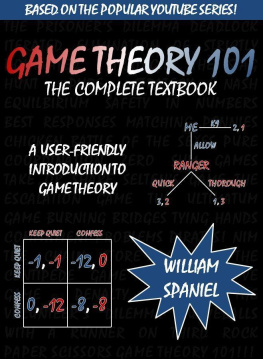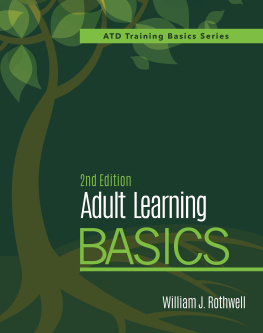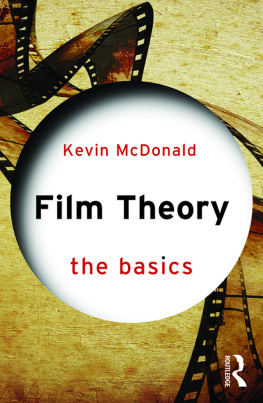William Spaniel - Game Theory 101: The Basics
Here you can read online William Spaniel - Game Theory 101: The Basics full text of the book (entire story) in english for free. Download pdf and epub, get meaning, cover and reviews about this ebook. year: 2011, publisher: n/a, genre: Children. Description of the work, (preface) as well as reviews are available. Best literature library LitArk.com created for fans of good reading and offers a wide selection of genres:
Romance novel
Science fiction
Adventure
Detective
Science
History
Home and family
Prose
Art
Politics
Computer
Non-fiction
Religion
Business
Children
Humor
Choose a favorite category and find really read worthwhile books. Enjoy immersion in the world of imagination, feel the emotions of the characters or learn something new for yourself, make an fascinating discovery.
- Book:Game Theory 101: The Basics
- Author:
- Publisher:n/a
- Genre:
- Year:2011
- Rating:3 / 5
- Favourites:Add to favourites
- Your mark:
- 60
- 1
- 2
- 3
- 4
- 5
Game Theory 101: The Basics: summary, description and annotation
We offer to read an annotation, description, summary or preface (depends on what the author of the book "Game Theory 101: The Basics" wrote himself). If you haven't found the necessary information about the book — write in the comments, we will try to find it.
Game Theory 101: The Basics — read online for free the complete book (whole text) full work
Below is the text of the book, divided by pages. System saving the place of the last page read, allows you to conveniently read the book "Game Theory 101: The Basics" online for free, without having to search again every time where you left off. Put a bookmark, and you can go to the page where you finished reading at any time.
Font size:
Interval:
Bookmark:
Game Theory 101: The Basics
By William Spaniel
Copyright William Spaniel, 2011.
All rights reserved.
Acknowledgements
I thank Varsha Nair for her revisions as I compiled this book. I am also indebted to Kenny Oyama and Matt Whitten for their further suggestions.
Please report possible errors to . Since this is an electronic book, I will issue corrections whenever appropriate.
Table of Contents
Lesson 1.1: The Prisoners Dilemma and Strict Dominance
Lesson 1.2: Iterated Elimination of Strictly Dominated Strategies
Lesson 1.3: The Stag Hunt, Pure Strategy Nash Equilibria, and Best Responses
Lesson 1.4: Dominance and Nash Equilibrium
Lesson 1.5: Matching Pennies and Mixed Strategy Nash Equilibrium
Lesson 1.6: Calculating Payoffs
Lesson 1.7: Strictly Dominant Mixed Strategies
Lesson 1.8: The Odd Rule and Infinitely Many Equilibria
Final Thought
About the Author
Lesson 1.1: The Prisoners Dilemma and Strict Dominance
The prisoners dilemma is the oldest and most studied game in game theory, and its solution concept is also the simplest. As such, we will start with it.
Two thieves plan to rob an electronics store. As they approach the backdoor, the police arrest them for trespassing. The cops suspect that the pair had planned to break in but lack the evidence to support such an accusation. They therefore require a confession to charge the suspects with the greater crime.
Having studied game theory in college, the interrogator throws them into the prisoners dilemma. He privately sequesters both robbers and tells them the following:
We are currently charging you with trespassing, which calls for a one month jail sentence. I know you were planning on robbing the store, but right now I cannot prove itI need your testimony. In exchange for your cooperation, I will dismiss your trespassing charge, and your partner will be charged to the fullest extent of the lawa twelve month jail sentence.
I am offering your partner the same deal. If both of you confess, your individual testimony is no longer as valuable, and your jail sentence will be eight months each.
If both criminals are self-interested and only care about minimizing their jail time, should they take the interrogators deal?
Solving the Game
The story contains a lot of information. Luckily, we can condense everything we need to know into a simple matrix:

We will use this type of game matrix regularly, so it is important to understand what it means. There are two players in this game. The first players moves (keep quiet and confess) are in the rows, and the second players moves are in the columns; the first players payoffs are listed first for each outcome, and the second players are listed second. For example, if the first player keeps quiet and the second player confesses, then the game ends in the top right set of payoffs, with the first player receiving twelve months of jail time and the second player receiving zero. Finally, as a matter of convention, we refer to the first player as a man and the second player as a woman; this will allow us to utilize pronouns like he and she instead of repeating player 1 and player 2 ad nauseam .
So what is each players optimal strategy? To see the answer, it is best to look at each move in isolation. Look at this from the perspective of player 1. Suppose he knew player 2 would keep quiet. What should he do? Lets check the important information in that context and replace everything that does not matter with a question mark:

From this, it is clear that player 1 should confess. If he keeps quiet, he will spend one month in jail. But if he confesses, he walks away. Since he prefers less jail time to more jail time, he should confess in this situation. Note that player 2s payoffs are completely irrelevant to player 1s decision in this contextif he knows that she will keep quiet, then he only needs to look at his own payoffs to decide which strategy to pick. Thus, the question marks could be any number at all, and player 1s decision will remain the same.
Now suppose player 1 knew that player 2 would confess. What should he do? Again, the answer is easier to see if we look at the only information that matters here:

Confession wins a second time: confessing leads to eight months of jail time, whereas silence buys twelve. So player 1 would want to confess if player 2 confesses.
Putting these two pieces of information together, we reach an important conclusionplayer 1 is better off confessing regardless of what player 2 does! Thus, player 1 can effectively ignore whatever he thinks player 2 will do, since confessing gives him less jail time in either scenario.
Now lets take player 2s perspective. Suppose she knew that player 1 will keep quiet, even though we realize he should not. Here is her situation:

As before, player 2 should confess, as he will shave a month off her jail sentence for doing so.
Finally, suppose she knew player 1 will confess. How should she respond?

Unsurprisingly, she should confess and spend four fewer months in jail.
Once more, player 2 is better off confessing regardless of what player 1 does. Thus, we have reached a solution: both players confess, and both players spend eight months in jail. The justice system has triumphed, thanks to the interrogators savviness!
This outcome perplexes a lot of people new to the field of game theory. Looking at the game matrix, they see that the outcome leaves both players better off than the outcome and wonder why the players cannot coordinate on the more efficient outcome. But as we just saw, any promise to keep quiet is unbelievable. Player 1 wants player 2 to keep quiet so when he confesses he walks away freely. The same goes for player 2. As a result, the outcome is inherently unstable, which is why the players ultimately end up in the inferior (but sustainable) outcome.
Meaning of the Numbers
Although there is a large branch of game theory devoted to the study of expected utility, we generally consider each players payoffs as a ranking of his most preferred outcome to his least preferred outcome. In the prisoners dilemma, we assumed that players only wanted to minimize their jail time. Game theory does not force players to believe that is the case, as critics frequently claim. Instead, game theory analyzes what should happen given what players desire. So if players only want to minimize jail time, we could use the negative number of years spent in jail as their payoffs. This preserves their individual orderings over outcomes, as the most preferred outcome is worth 0, the least preferred outcome is -10, and everything else logically follows in between.
Interestingly, the cardinal values of the numbers are irrelevant to the outcome of the game. For example, suppose we changed the matrix to this:

Here, we have replaced the months of jail time with an ordering of most to least preferred outcomes, with 4 representing a players most preferred outcome and 1 representing a players least preferred outcome. In other words, player 1 would most like to reach the outcome, then the outcome, then the outcome, then the outcome.
Next pageFont size:
Interval:
Bookmark:
Similar books «Game Theory 101: The Basics»
Look at similar books to Game Theory 101: The Basics. We have selected literature similar in name and meaning in the hope of providing readers with more options to find new, interesting, not yet read works.
Discussion, reviews of the book Game Theory 101: The Basics and just readers' own opinions. Leave your comments, write what you think about the work, its meaning or the main characters. Specify what exactly you liked and what you didn't like, and why you think so.













